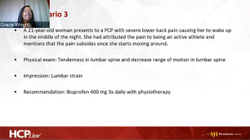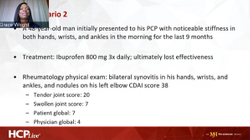Grace Wright. MD, PhD Reviews Challenging Cases of Rheumatic Diseases - Episode 1
Case Study 1: Psoriatic Arthritis Patient Case Overview and Therapeutic Goals
Transcript:
Wright, MD: Our first case we’ll be going through 3 different disease states and I really would enjoy having your conversations on this.
We have a 31-year-old Caucasian woman who presents to her primary care provider complaining of intermittent body aches and difficulty picking up her child and cleaning her home. Her past medical history is significant. Her first 6-year history of scalp psoriasis that she has controlled with over-the-counter products: a salicylic acid shampoo, most notably. Her prior history is a questionable story of maybe having had multiple sclerosis and some bowel symptoms that were attributed to irritable bowel syndrome.
On physical examination, she has tenderness over both elbows, her metacarpalpophalangeal [MCP] and proximal interphalangeal [PIP] joints on both hands. She also has the PIP joints of the right hand and the right knee. Swollen joints are noted in the right knee and the proximal and distal joints of the right hand, so there’s a little discordance of some joints being swollen and tender at the same time.
Her neurological exam that day showed no sensory deficits or hyperesthesia. Her motor exam was unremarkable, and her chest and abdominal findings were unremarkable. We have a story of a young woman who is achy and who has some swollen and tender joints. Further examination reveals a blood pressure that is borderline at 138/90 and on an x-ray imaging we see asymmetric erosive changes with very small areas of bony proliferation in the PIP joints, and the report sort of reads possible degenerative disease.
There’s narrowing of the joint space in the interphalangeal joints. There’s really no comment as to whether that’s symmetric narrowing or asymmetric narrowing. The laboratory findings: her sedimentation rate is 35; normal is up to 20 in this lab. Rheumatoid factor is negative. The antinuclear antibody is negative, and her C-reactive protein is 7 mg/dL; normal in this lab is 3 or less.
The 2018 American College of Rheumatology/National Psoriasis Foundation guidelines walk us through if you’re treatment naive or if you’re already gone through therapies. With treatment naïve psoriatic arthritis, it says here there’s 4 different ways to start which then tells us you can just do whatever you want essentially. You could start with a tumor necrosis factor [TNF]. You could start with methotrexate over nonsteroidal anti-inflammatory drugs. You could start with an interleukin- [IL-] 17 or IL-12/23. You can start with an oral small molecule, which is the janus kinases [JAK] inhibitors, and if they don’t respond and if they’re still active then you switch to whatever it is you have not started. They are sort of very loose.
In the beginning it was that you start always with a TNF. You had to fail TNF’s and go through a second TNF before you would switch mechanism of action, but that has actually changed. But this as you mentioned for some young women of childbearing age who might want to have another pregnancy shortly, maybe starting methotrexate is not her priority. I would not offer it until we obtain that goal, but, again, I always say when my patients start talking about pregnancy it means they’re probably already pregnant. It’s a little too late; they want to bring that up and just put it on the table and say, “so what are your thoughts about having a child.” I don’t even consider methotrexate in that group because it’s just going to be a nightmare in terms of getting them on and off. These are the guidelines that we have right now.
So, despite all of that this doctor put her on methotrexate. He started her at 15 mg and escalated her to 50 mg a week of oral methotrexate. She’s still complaining of symptoms, and similar symptoms or may be not as bad. Her erythrocyte sedimentation rate is 30, and her complete blood count chemistry is normal. c-reactive protein has come down a little bit to 3 mg/dL.
Here I wanted to just give us a sampling now of all the things that we have available, and they’re sort of grouped by class. You have the TNF’s. You have the interleukin 12/23 inhibitor, 2 il-17a inhibitors, an IL-17A is on the way. Guselkumab was just approved, as well, for psoriatic arthritis. We have 2 JAKS. Well, actually, we have 3 JAKS, but only 1 is approved for PSA at this point. Two more are on the turnpike abatacept is a T cell inhibitor and a primal asset we’ve been focusing on, so it is quite an array that we have. We will do a brief safety analysis across the spectrum just to show the difference in the safety profile in that collated data.
Transcript Edited for Clarity



